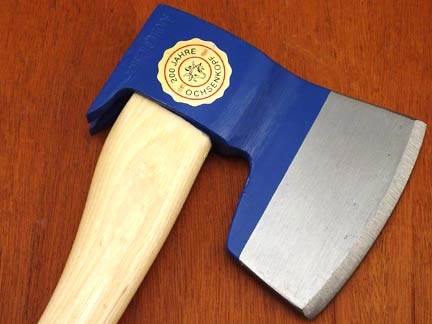Axes (Download)
Axes 1 Axe – Definition An implement consisting of a heavy metal wedge-shaped head with one or two cutting edges and a relatively long wooden handle; used for chopping wood and felling trees. http://www.answers.com/topic/axe-1 2 History of the Axe The first true hafted axe dates back to before 6000 BC. Early axes had heads of stone with some form of wooden handle In past cultures, axes were sacred, symbolic, and even used as weaponry. http://www.bali-travel-life.com/bali-history.html 3 Description & Use Axe belongs to the family of Hand tools. Depending upon its use, it can be made up of different types of blades and handles. The most common uses of axes are to shape, split and cut wood, harvest timber, or as a weapon. Until recently, the axe was an integral part of the carpenter’s tool kit. In the construction industry, axes are mainly used for making stakes or wedges and splitting or shaping rough timbers. http://en.wikipedia.org/wiki/File:An_axe_labelled-2edit.svg 4 Types of Axes Axes are of two basic types: single or double bit. Single-bit axes have one cutting edge opposite a flat face. The single-bit axe is used when safety is paramount. Double-bit axes have two symmetrically opposed cutting edges. Some workers prefer the double-bit ax. One edge is maintained at razor sharpness and the other is kept somewhat duller for chopping around rocks or dirt. Mark the duller edge with a spot of paint. http://www.fhwa.dot.gov/environment/fspubs/05232810/page06.htm 5 Types of Axes Felling Axe Used while cutting across the grain of wood. This is the most commonly used Axe 6 Types of Axes Splitting Axe Used when cutting with the grain of the wood . Has a longer, narrower head than the traditional felling axe 7 Types of Axes Broad Axe Used for precision cutting. Has a very narrow head. 8 Axe Head Types Source: http://www.fhwa.dot.gov/environment/fspubs/05232810/page06.htm Various axe head types 9 Safety Concerns Axe injuries typically occur due to: Failure to use it for the right job Failure to use the tool correctly Failure to keep edges sharp Failure to replace or repair defective components Failure to store tools safely 10 Safety Concerns Splintered axe handles Defective tools Blunt edges of the tool Insufficient or no PPE Storing of tools improperly without blade covering The major problem with the safety of axes is that workers take it lightly as it is an everyday hand tool. Listed are some of the major safety concerns: http:// ehsd.tamu.edu/documents/TAMUSafetyManual/04-shopa.htm#hand http://www.fhwa.dot.gov/environment/fspubs/99232823/fig106.jpg 11 Fatalities There were no OSHA-investigated fatalities that were associated with the use of axes. Source: Extracted from OSHA Accident Investigation Data 1990-2009 12 Injuries Due to Axes Types of Injuries: Reason for injuries: Axe slipped Victim slipped Missed intended object Axe bounced off Not wearing PPE http://www.healthline.com/blogs/outdoor_health/uploaded_images/laceration-joslin-701951.jpg Finger Lacerations Hand & Leg Lacerations Sprains & Strains Infections due to injuries can be fatal 13 Injury Facts Most injuries caused by axes are caused either by: Overexertion Being struck by the axe Injuries typically occur in the following locations: Finger Torso Back Lower Body 14 A worker was driving wedges when he missed the object and hit the victim standing next to it. The victim suffered a laceration on his foot . Axe Injuries Case 1: http://orangecemeterydepartment.wordpress.com/2010/02/04/tree-removal-winter-2010/ 15 Axe Injuries A worker was using an axe when the handle split and part of it went right through his finger. This accident could have been avoided if the axe was checked before use. Case 2: http://www.ehow.com/how_7302444_replace-ax-handle.html 16 A worker was cutting iron bands on bales of cotton. He cut 10 bands for 2 minutes and when he lifted the axe to cut the 11 th band, the axe head slipped and struck the employer’s husband walking 5 floors below. The worker had used the axe for 2 years before the accident occurred and had no problem with it. On that particular day, he made no particular examination before using the axe. This accident could have been avoided if the employee had examined the axe properly before using it. The fact that the axe head slipped proves that the tool was defective. Case 3: http://books.google.com/books?id=RUKTAAAAIAAJ&pg=PA433&lpg=PA433&dq=injuries+due+to+axe+accidents&source=bl&ots=Yg83eQEJnM&sig=OmTYA9d2mZr31mBZ_X2nyckSszk&hl=en&ei=4MrcSZ_sG43CtweWlsiCDQ&sa=X&oi=book_result&ct=result&resnum=7#PPA434,M1 Axe Injuries 17 OSHA Regulations 1910.266(e)(1)( i ) The employer shall assure that each hand and portable powered tool, including any tool provided by an employee, is maintained in serviceable condition. 1910.266(e)(1)(ii ) The employer shall assure that each tool, including any tool provided by an employee, is inspected before initial use during each workshift. At a minimum, the inspection shall include the following: 1910.266(e)(1)(ii)(A ) Handles and guards, to assure that they are sound, tight-fitting, properly shaped, free of splinters and sharp edges, and in place; 18 OSHA Regulations OSHA classifies axes as a “Hand Tool” According to OSHA 1926.300a All Hand tools whether furnished by the employer or the employee shall be maintained in safe condition. 19 OSHA Regulations OSHA 1926.301: Employers shall not issue or permit the use of unsafe hand tools. d) The wooden handles of tools shall be kept free of splinters or cracks and shall be kept tight in the tool. 20 Best Practices – PPE Safety Glasses Work Boots Work Gloves No Loose Clothing 21 Best Practices The axe head must be kept sharp and free of burrs. The handle must be tightly set into the head and free of splits. The axe head must be pinned to the handle. The axe head should be 2 1/2 to 5 pounds or more when working large timber. This makes driving wedges easier, with less shock to the arms and shoulders. The axe head should be wide and square enough to make good contact with the wedges. If worn on the belt, the axe must be sheathed. http://www.fhwa.dot.gov/environment/fspubs/05232810/page06.htm 22 Best Practices Before chopping, check for adequate swing clearance and stable footing. Chop only when clear of other workers. Stand with body weight evenly distributed and both feet planted shoulder-width apart. Measure the correct distance to stand from the cut by holding the handle near the end and stretching the axe head out, touching the cut. Begin chopping by sliding one hand within 6 inches of the head. As the swing progresses, slide the top hand back down the handle towards other hand. Just after impact, give the handle a slight twist to pop severed wood out of the cut. http://www.fhwa.dot.gov/environment/fspubs/05232810/page06.htm 23 Best Practices The force of the swing is not as important as accurate placement. Always chop away from the body. Stand so a glancing blow will not cause injury. If forced to cut toward the body, “choke up” on the handle with both hands and use short swings to get more control. Chopping through a log requires a cut width twice the log’s diameter to prevent the sides from converging. If opposing cuts are used, make each as wide as the log’s diameter. http://www.fhwa.dot.gov/environment/fspubs/05232810/page06.htm 24 Best Practices When limbing, cut on the underside of limbs and not in the crotch. Fewer chops are required and there is less chance that the axe will wedge between the branch and trunk or glance off. Not doing so makes the axe more likely to chip blades because crotch wood is dense. When chopping branches above the crotch, place something solid under the chopping point to prevent the branch from springing back and striking the worker. http://www.fhwa.dot.gov/environment/fspubs/05232810/page06.htm 25 Best Practices If the blade must be sharpened, maintain the original shape as much as possible. Discard axes with poor profiles or cracked heads. Grind the blade slowly, arcing with the grinder toward the blade’s midpoint so it has a full-width convex bevel. Be careful not to hollow grind blades, which produces a concave blade bevel the radius of the grinding wheel. Finish with a mill bastard file and an axe stone. When sharpening in the field, secure the axe so both hands are free. A double-bit can be lodged in a tree stump or log, and a single-bit can be secured with the butt end in a V- notch. Wear gloves on both hands, and use a file guard on the file. Finish with an axe stone. http://www.fhwa.dot.gov/environment/fspubs/05232810/page06.htm 26 Best Practices Carry axes hip-side with the head forward. Grasp the handle firmly just behind the head and keep the cutting edge away from the body and pointed down. Sheath all axes before transporting. Have a specific place for axes and rack them with the heavy end down. The axe head must be properly sheathed after finishing the work . Must be properly stored: http://www.fhwa.dot.gov/environment/fspubs/05232810/page06.htm 27 Think Safety Work Safely 28

